I would like to begin this week’s report by condemning the actions taken by insurrectionists during Wednesday’s siege on the United States Capitol. The nation’s collective heart breaks at the violence instigated by the president, his supporters and right-wing media. History will remember those who were complicit, aided and abetted Wednesday’s events. We will heal and build back better.
Welcome back to Week 39 in my weekly reports analyzing the Covid-19 pandemic and its effects on the country and higher education, and happy new year to all. For those of you reading this on my blog, Off the Silk Road, I have also launched a newsletter, where these reports can be sent directly to your email each week. Click here to subscribe.
Last week, we discussed the new variant first discovered in the UK and dissected the Trump administration’s failed vaccine rollout. This week, we will review a host of new scientific studies and begin to understand the ramifications from viral transmission from Wednesday’s events.
A national look
Despite the nation’s focus on various actions this week for (certifying the Electoral College vote) and against democracy, the pandemic continues to rage across the U.S. According to the COVID Tracking Project, the U.S. recorded 310,000 new cases on Friday, with hospitalizations over 130,000. According to the CDC, 63 cases of the new variant first discovered in the UK have been detected in the U.S. As experts have called to aggressively suppress transmission in order to slow the new variant’s spread, recent case counts from the UK and Ireland may serve as warnings.
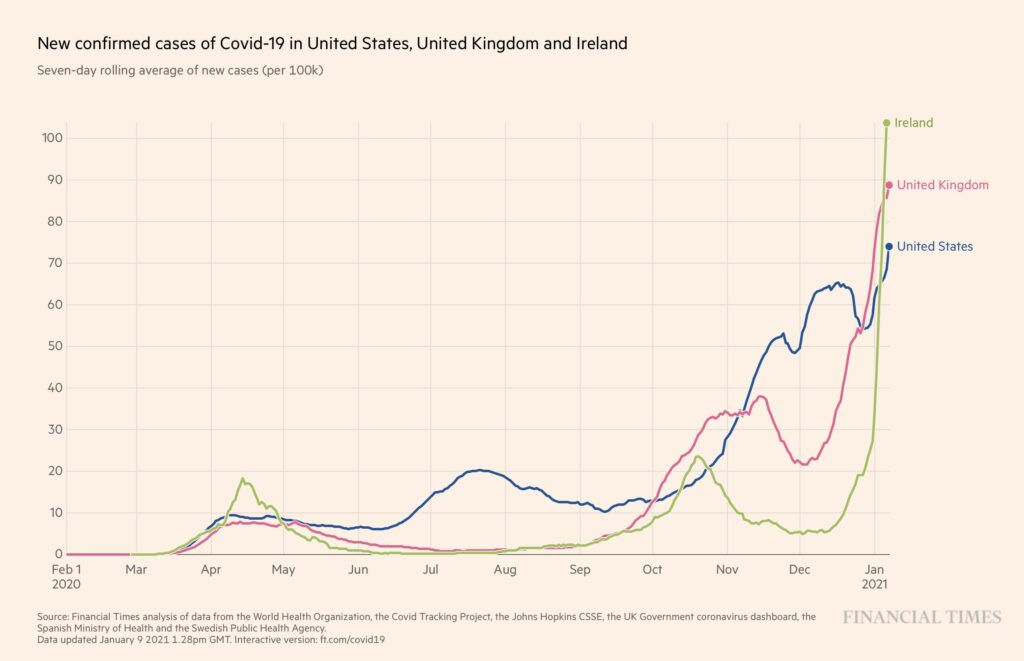
As the reporting backlog from the New Year holiday has mostly caught up, it will be impossible to quantify the superspreader potential from Wednesday’s storming of the Capitol. “I am worried not only that it could lead to super-spreading, but also super-spreading to people who are elected officials,” Johns Hopkins’ Dr. Tom Inglesby told The New York Times. As many of the rioters have now left Washington, they will only spread it further in their home communities. New data from the COVID Tracking Project show overloaded hospitals across the country, with some hospitals in California and Georgia having over 45% of their beds occupied by Covid-19 patients.
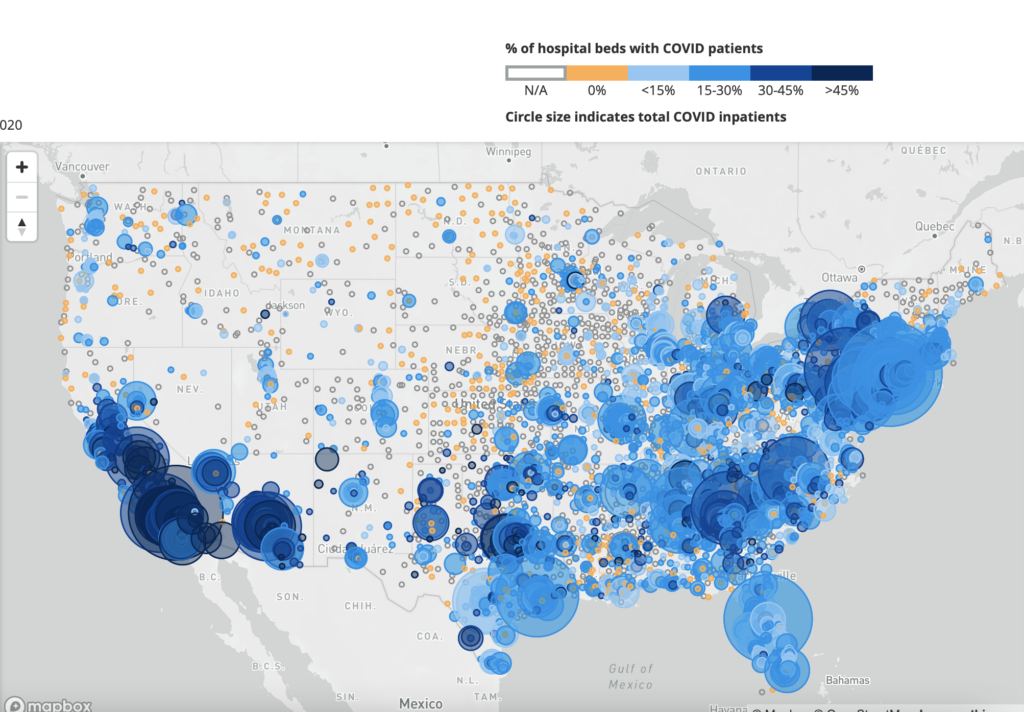
America has now chosen to rely on the vaccine as its silver bullet for exit out of this pandemic, despite over 4,000 Americans dying this past Thursday alone and the 7-day average of deaths being over 3,000. Doctors have faced unprecedented levels of cyberbullying as America continues into its death spiral of pandemic fatigue. While science-based leadership will arrive in the White House in 10 days, over 2 million people have been diagnosed with Covid-19 since January 1.
Let’s take a look at some of the latest scientific developments:
- According to a new report published in JAMA, an estimated 14.3% of the U.S. population had antibodies against Covid-19 by mid-November 2020, suggesting that that the virus has infected vastly more people than reported. Additionally, approximately 35% of Covid-19 deaths are not reported.
- A new report from China’s CDC shows a student who returned to China from the UK, tested negative before travel and tested positive upon arrival with the B.1.1.7 variant. All known contacts were quarantined and no onward transmission has been documented yet.
- A preprint from a migrant farmworker population in California shows that test positivity was 28% higher for farmworkers than for non-farmworkers from the same communities.
- The FDA has warned that the Curative test (used in many LA test sites and in Congress) may yield false negative results.
- According to a new CDC study, on a flight to New Zealand, 5 passengers had negative Covid-19 tests prior to departure and subsequently tested positive. This shows that despite pre-departure testing, multiple instances of in-flight SARS-CoV-2 transmission are likely.
- People with no symptoms transmit more than half of all cases of the novel coronavirus, according to a model developed by researchers at the CDC. That includes 35% of new cases from people who infect others before they show symptoms and 24% from people who never develop symptoms at all.
- More than 360 people have tested positive in a growing Covid-19 outbreak south of Beijing in neighboring Hebei province, with millions people now placed under a stay-at-home order.
- A new CDC report using data from Vermont shows that among the close contacts in quarantine who tested negative at day 7 after exposure, none who were retested between day 8 and 14 were positive and just 3% tested positive at day 7. Allowing asymptomatic persons to shorten quarantine with a negative test at day 7 or later has not been demonstrated to result in transmission of SARS-CoV-2, indicating that the policy has been effective. These results also indicate that 3.9% of contacts tested on days 7–10 after exposure were infected with SARS-CoV-2.
- According to a CDC report, rates of Covid-19 among nursing home residents and staff members increased during June and July 2020, and again in November. Trends in reported Covid-19 cases among nursing home residents and staff members were similar to trends in incidence of Covid-19 in surrounding communities.
- A study of the largest cohort of “Long Covid” patients published in The Lancet shows that 6 months post-hospital, 6% still had ≥ 1 symptom and 13% had abnormal kidney function, among other complications.
Finally, some updates on vaccines.
- Earlier in the week, I published a multifaceted vaccine plan on Twitter, advocating for fairgrounds, convention centers and sports stadiums to be converted into mass vaccination sites. You can read my full geographic analysis and suggestions for implementation here.
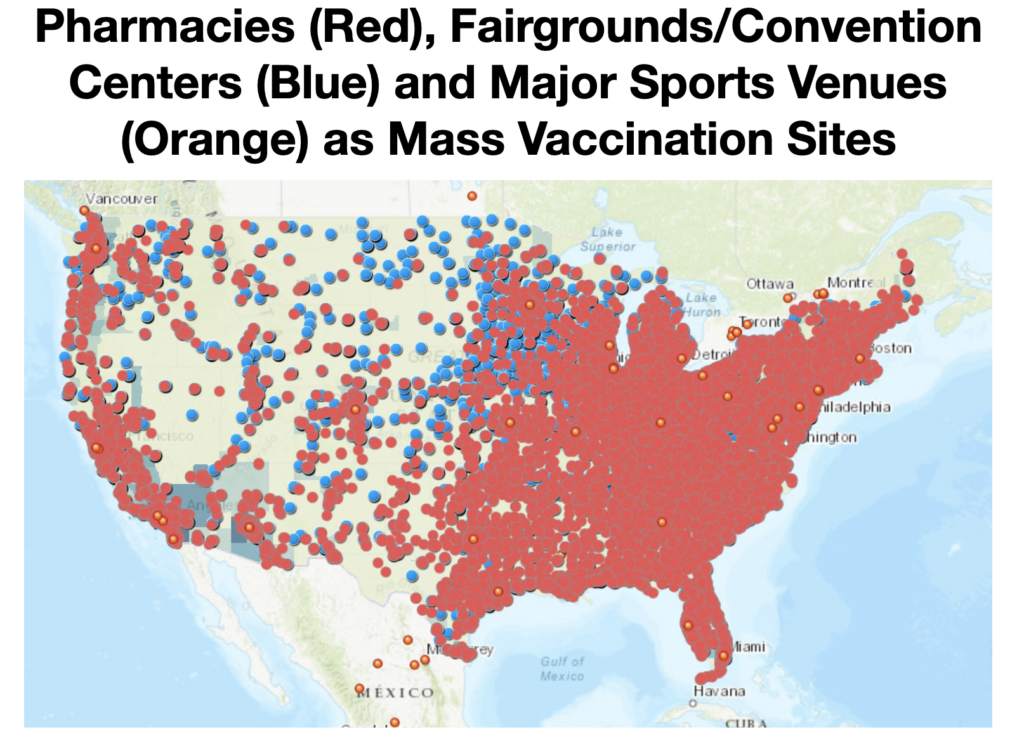
- Earlier in the week, the FDA was scheduled to meet to consider half-doses of the Moderna vaccine in order to vaccinate more people; however, no changes to the dosing regimen are recommended at this time.
- The Moderna vaccine has received authorization in the UK.
- The Pfizer vaccine appears to work against a key mutation in the highly transmissible new variants of the coronavirus discovered in the UK and South Africa, according to a new study the company conducted.
- A commentary published in the New England Journal of Medicine argues for a multifaceted promotion and marketing strategy for increasing vaccine uptake.
- Confidence in the Covid-19 vaccine is growing, with now close to 60% of respondents saying they would get a vaccine, according to a USA Today analysis of dozens of polls and scientific papers.
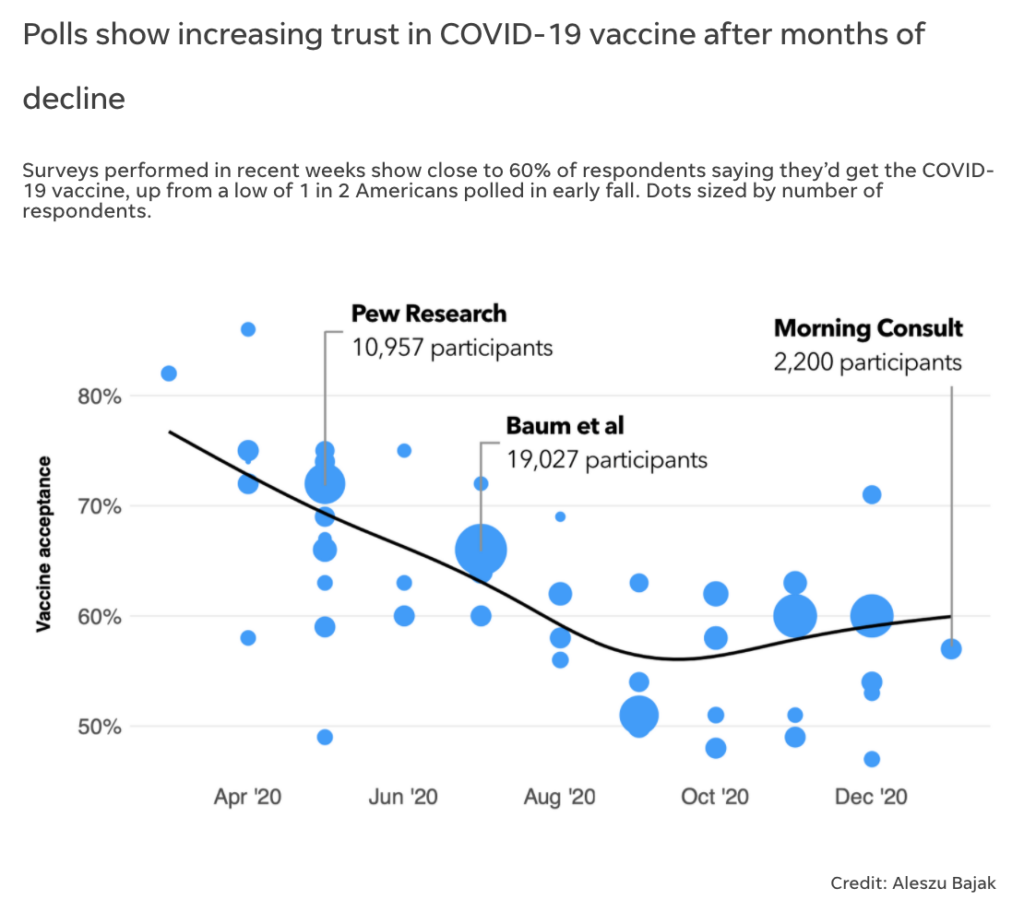
- This week, three studies were published in the Annals of Internal Medicine which provide valuable viewpoints on vaccine distribution. First, modeling from Yale professors makes the case for a single-dose regimen assuming a 75% efficacy with one dose. This would mean that the same number of infections would be averted at this level compared to a two-dose regimen. Next, despite evidence of data from clinical trials other researchers argue for the consideration of a single-dose regimen in order to accelerate pandemic control. Finally, a third study suggests a more dynamic strategy of reserving second doses: holding 10% of the supply for second doses during the first 3 weeks, 90% during each of the next 3 weeks, and 50% thereafter.
- Possibly after consideration of the final study listed above, the incoming Biden administration has said it will accelerate the distribution of doses by not holding back second doses, assuming that manufacturing will pick up pace.
- According to a new CDC report, during December 14–23, 2020, monitoring by the Vaccine Adverse Event Reporting System detected 21 cases of anaphylaxis after administration of a reported 1,893,360 first doses of the Pfizer-BioNTech Covid-19 vaccine (11.1 cases per million doses); 71% of these occurred within 15 minutes of vaccination. For comparison, the flu vaccine anaphylaxis rate is 1-2 cases per million. It must be emphasized that these adverse events are rare and can be treated, unlike some cases of Covid-19.
- The Vaccine Allocation Dashboard has now been revamped to show CDC data for doses distributed and administered by state, which is updated each weekday. I was pleased to see the dashboard included in Dr. Carlos del Rio’s presentation at an Emory School of Medicine virtual town hall on Friday. The latest update shows 22,137,350 doses distributed nationwide and 6,688,231 doses administered. While vaccinations have started to pick up (approaching 1 million per day), we still have a long way to go before a rapid vaccine rollout.
Let’s move on to our discussion of higher education.
Higher education
Here’s a roundup of this week’s higher ed news:
- As some colleges have begun to bring students back for the winter/spring semesters, many have already been faced with a large number of cases on campus. 43 Stanford students had tested positive in 6 days and cases at Arizona State are higher than the start of school in the fall. Higher community transmission nationwide underscores the need for colleges to mount higher defenses than the fall, including robust entry testing. Just last night, Stanford reversed its plans to bring first-years and sophomores to campus for the upcoming winter quarter. Expect more colleges to push start dates back, including UNC. It’s July and August all over again. I’d urge them to announce calendar changes sooner rather than later.
- Last week, the American College Health Association published new recommendations for colleges to reopen in the spring. “The campus community should be tested on a scheduled, recurring basis, with the ideal timing of twice weekly for students with test result turnaround times of <24-48 hours,” according to the guidelines.
- Expect colleges to wrestle with the question of requiring Covid-19 vaccines for students when they are available.
- According to a new CDC report, counties with large colleges or universities with remote instruction saw a 17.9% decrease in Covid-19 incidence from July to September. Those without a college saw a 6% decrease in incidence, and those with in-person instruction saw a 56% increase in incidence.
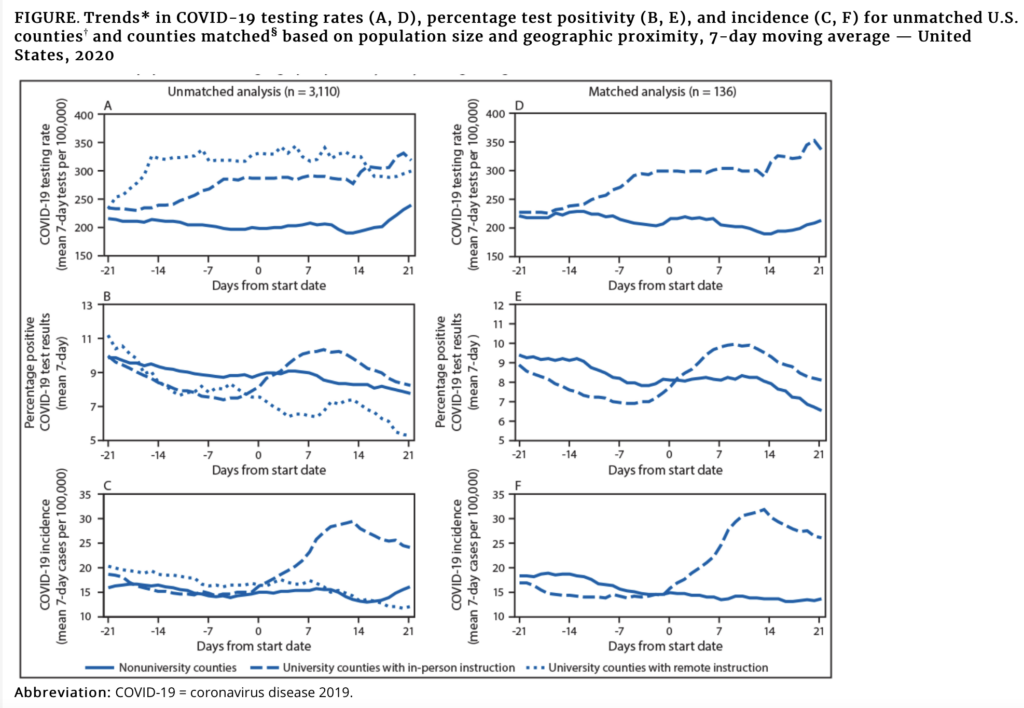
- Some students at Dartmouth have voiced concerns over the availability of support from the college should they become infected. According to several students who contracted Covid-19 during the fall term, the college’s academic and mental health support systems were inadequate during their illness and recovery.
- A new preprint on possible heart complications from 55 college athletes found no myocarditis, one pericarditis and one cardiomyopathy (thought to be unrelated to Covid).
- Even before the start of the spring semester, the University of Florida has already made some interesting decisions. It estimates that only 61% of students will be tested before the first day of class and students do not need a negative test result to be cleared (just having been tested is sufficient). Additionally, faculty could face disciplinary action for moving in-person classes online for longer than one day if the course modality was not originally scheduled as online.
- According to a new CDC report, among exposed athletes, 25% had positive test results during quarantine. Among athletes who had not received a positive test result by Day 5, the probability of testing positive decreased from 27% after Day 5 to <5% after Day 10.
- A new CDC report from an Arkansas college shows that Covid-19 cases increased rapidly in the fall, mostly through gatherings. 91% of gatherings were associated with fraternity or sorority activities. Recruitment events held virtually were associated with fewer cases than those held in person.
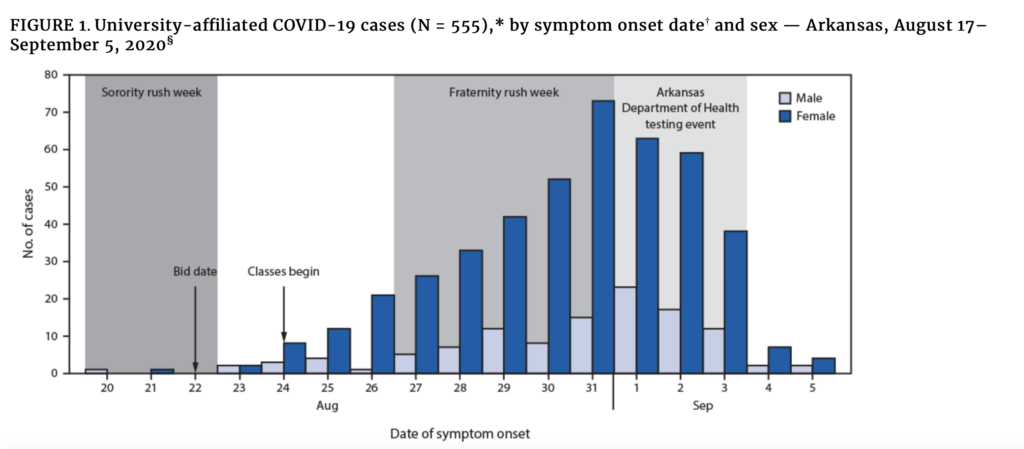
I hope colleges will continue to use lessons learned from the fall to guide spring openings, as high levels of transmission nationally will make mitigation measures critical.
The Good Stuff
Let’s roll the clips of the good stuff. In my usual tradition, I feature my favorite stories from the week. Here are my Top 10.
- One Florida reporter has done an invaluable service to her community, answering community members’ questions on Covid-19 vaccines.
- Educators have found creative ways to reach kids through remote learning, including treehouse teaching and laundry art.
- The Chronicle of Higher Education has set up a useful interactive where you can see the colleges attended by the past 5 administrations’ cabinet members.
- Friends and colleagues pay tribute to Brian Sicknick, the Capitol police officer who lost his life after a pro-Trump mob assaulted the Capitol.
- New York Magazine’s Olivia Nuzzi commends the White House press corps for their hard work and dedication over the past four years.
- After rioters stormed the Capitol, it was a number of quick staffers who grabbed the boxes containing the Electoral College votes.
- Congressman Jamie Raskin wrote a beautiful and touching tribute to his son, who, so sadly, took his own life last week.
- What started as a Covid-19 vaccine appointment ended in a marriage proposal for two South Dakota health care workers.
- CNN’s Allison Gordon summarizes this week in headlines.
- In President Trump’s final days in the White House, I have worked with my colleague Becca Foley to create a tracker illustrating administration resignations, calls for impeachment and Twitter account suspensions. (One of our tweets advertising the tracker has received over 1.6 million views.)
Conclusion
President Trump has 10 days left in office, and the pandemic will not be at the top of his priorities, furthering his inaction to solve a devastating health crisis. Deaths will top 3,000 each day for a number of weeks, some even topping 4,000, and it is quite likely that 400,000 Americans will have died from Covid-19 by the time Joe Biden takes office. While the vaccine rollout is speeding up, we need to accelerate its pace and continue to slow transmission. The actions we take now will save lives weeks later.
I’d like to thank all the student journalists with whom I have the pleasure of working. In the next weeks and months ahead, they will become vital in chronicling their colleges’ paths forward for the spring and beyond. Support their work by reading it.
My best to all for good health.
Like what you see? Don’t like what you see? Want to see more of something? Want to see less of something? Let me know in the comments. And don’t forget to subscribe to the weekly newsletter!
For more instant updates, follow me on Twitter @bhrenton.



1 Comment
Harry Goldhagen · January 10, 2021 at 1:41 pm
Thanks again, Benjy, for your sobering review of the ongoing health disaster. Here in Vermont, I fear that the visitors to DC (and the lack of basic Covid health steps) this past week will only accelerate our caseload, hospitalizations and deaths.
Comments are closed.